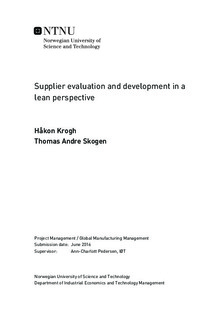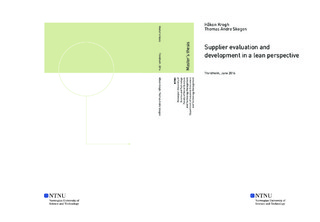| dc.description.abstract | Through a research project at NTNU, named Lean Management, this thesis was conducted with the purpose of finding out how the purchasing function of a firm, seeking to perform according to lean principles, can structure their supplier evaluation and development initiatives.
To achieve this, a literature study was conducted, which resulted in the development of a framework and subsequently a model. The model is based on themes from conventional and lean theory on purchasing, supplier evaluation, and supplier development.
The model consists of five steps and a continuous improvement methodology, where supplier measurements and evaluation of supplier performances are conducted in accordance with a combination of best practice and lean techniques. Suppliers deemed performing sufficient will be monitored and evaluated in a continuous feedback loop, while suppliers performing insufficient will be developed if possible, or terminated if not. The suppliers kept on will so be subjected through this continuous treatment so to enhance the overall supplier base performance level.
A descriptive case study was performed to validate the proposed supplier evaluation and development model. The data collected in order to build the case was obtained by conducting semi-structured interviews in two rounds with relevant personnel and managers in the case company. Additional data were collected from the corporate web page, through on-site tours, and e-mails with Nammo employees. The case description was subsequently used to analyse the applicability of the proposed model.
The results point towards the fact that the model would be of beneficial use to any purchasing department in structuring their supplier evaluation and development based on lean thinking. However, this requires dedication from the company wanting to utilise the model, and slight modifications to the model itself. Additional results indicate that the model could be used in a modular sense, i.e. parts of it only or focusing on single criteria instead of a holistic system. Limitations and further studies point to e.g. incorporating the aspect of delivery frequency in the model. | |

